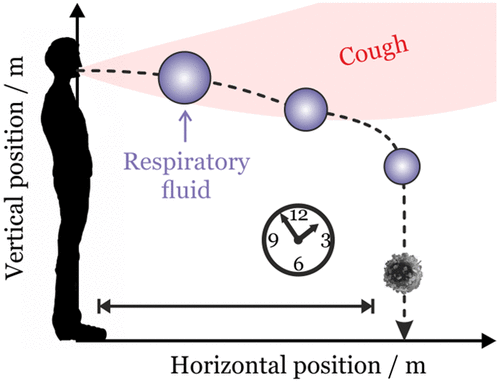当前位置:
X-MOL 学术
›
ACS Cent. Sci.
›
论文详情
Our official English website, www.x-mol.net, welcomes your feedback! (Note: you will need to create a separate account there.)
Accurate Representations of the Microphysical Processes Occurring during the Transport of Exhaled Aerosols and Droplets
ACS Central Science ( IF 18.2 ) Pub Date : 2021-01-05 , DOI: 10.1021/acscentsci.0c01522 Jim S. Walker 1 , Justice Archer 1 , Florence K. A. Gregson 1 , Sarah E. S. Michel 1 , Bryan R. Bzdek 1 , Jonathan P. Reid 1
ACS Central Science ( IF 18.2 ) Pub Date : 2021-01-05 , DOI: 10.1021/acscentsci.0c01522 Jim S. Walker 1 , Justice Archer 1 , Florence K. A. Gregson 1 , Sarah E. S. Michel 1 , Bryan R. Bzdek 1 , Jonathan P. Reid 1
Affiliation

|
Aerosols and droplets from expiratory events play an integral role in transmitting pathogens such as SARS-CoV-2 from an infected individual to a susceptible host. However, there remain significant uncertainties in our understanding of the aerosol droplet microphysics occurring during drying and sedimentation and the effect on the sedimentation outcomes. Here, we apply a new treatment for the microphysical behavior of respiratory fluid droplets to a droplet evaporation/sedimentation model and assess the impact on sedimentation distance, time scale, and particle phase. Above a 100 μm initial diameter, the sedimentation outcome for a respiratory droplet is insensitive to composition and ambient conditions. Below 100 μm, and particularly below 80 μm, the increased settling time allows the exact nature of the evaporation process to play a significant role in influencing the sedimentation outcome. For this size range, an incorrect treatment of the droplet composition, or imprecise use of RH or temperature, can lead to large discrepancies in sedimentation distance (with representative values >1 m, >2 m, and >2 m, respectively). Additionally, a respiratory droplet is likely to undergo a phase change prior to sedimenting if initially <100 μm in diameter, provided that the RH is below the measured phase change RH. Calculations of the potential exposure versus distance from the infected source show that the volume fraction of the initial respiratory droplet distribution, in this size range, which remains elevated above 1 m decreases from 1 at 1 m to 0.125 at 2 m.
中文翻译:

呼出气溶胶和小滴的运输过程中发生的微物理过程的准确表示。
呼气事件产生的气溶胶和飞沫在将病原体(如SARS-CoV-2)从感染的个体传播到易感宿主中起着不可或缺的作用。然而,在我们对干燥和沉淀过程中发生的气溶胶液滴微观物理以及对沉淀结果的影响方面,我们仍然存在很大的不确定性。在这里,我们将一种针对呼吸液液滴的微物理行为的新疗法应用于液滴蒸发/沉降模型,并评估其对沉降距离,时间尺度和颗粒相的影响。初始直径大于100μm时,呼吸液滴的沉积结果对成分和环境条件不敏感。小于100μm,尤其是小于80μm,增加的沉降时间使蒸发过程的确切性质在影响沉淀结果方面起着重要作用。在此尺寸范围内,对液滴成分的不正确处理或相对湿度或温度的不正确使用会导致沉降距离差异较大(代表值分别> 1 m,> 2 m和> 2 m)。另外,如果最初的直径小于100μm,则呼吸液滴可能会在沉淀之前经历相变,前提是RH低于测得的相变RH。潜在暴露量相对于与感染源的距离的计算表明,在此大小范围内,初始呼吸液滴分布的体积分数在1 m以上保持升高,从1 m处的1减小至2 m处的0.125。
更新日期:2021-01-27
中文翻译:

呼出气溶胶和小滴的运输过程中发生的微物理过程的准确表示。
呼气事件产生的气溶胶和飞沫在将病原体(如SARS-CoV-2)从感染的个体传播到易感宿主中起着不可或缺的作用。然而,在我们对干燥和沉淀过程中发生的气溶胶液滴微观物理以及对沉淀结果的影响方面,我们仍然存在很大的不确定性。在这里,我们将一种针对呼吸液液滴的微物理行为的新疗法应用于液滴蒸发/沉降模型,并评估其对沉降距离,时间尺度和颗粒相的影响。初始直径大于100μm时,呼吸液滴的沉积结果对成分和环境条件不敏感。小于100μm,尤其是小于80μm,增加的沉降时间使蒸发过程的确切性质在影响沉淀结果方面起着重要作用。在此尺寸范围内,对液滴成分的不正确处理或相对湿度或温度的不正确使用会导致沉降距离差异较大(代表值分别> 1 m,> 2 m和> 2 m)。另外,如果最初的直径小于100μm,则呼吸液滴可能会在沉淀之前经历相变,前提是RH低于测得的相变RH。潜在暴露量相对于与感染源的距离的计算表明,在此大小范围内,初始呼吸液滴分布的体积分数在1 m以上保持升高,从1 m处的1减小至2 m处的0.125。


























 京公网安备 11010802027423号
京公网安备 11010802027423号